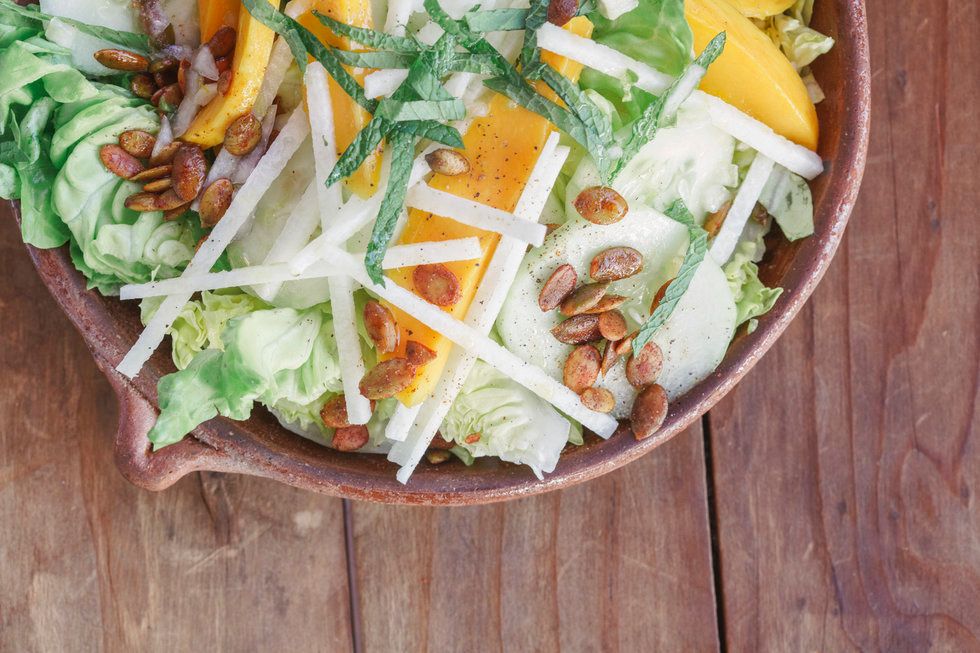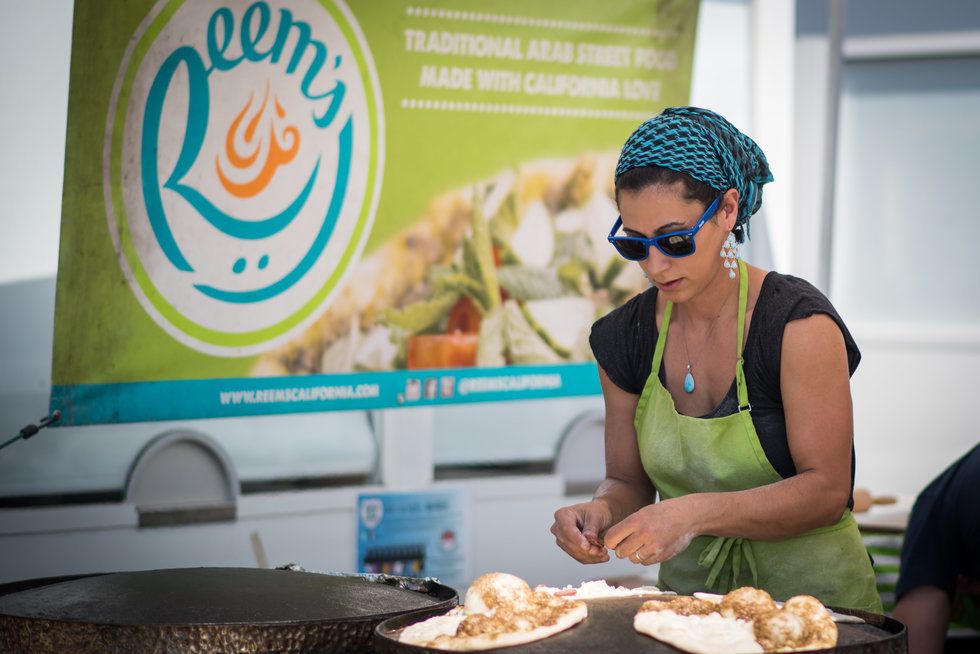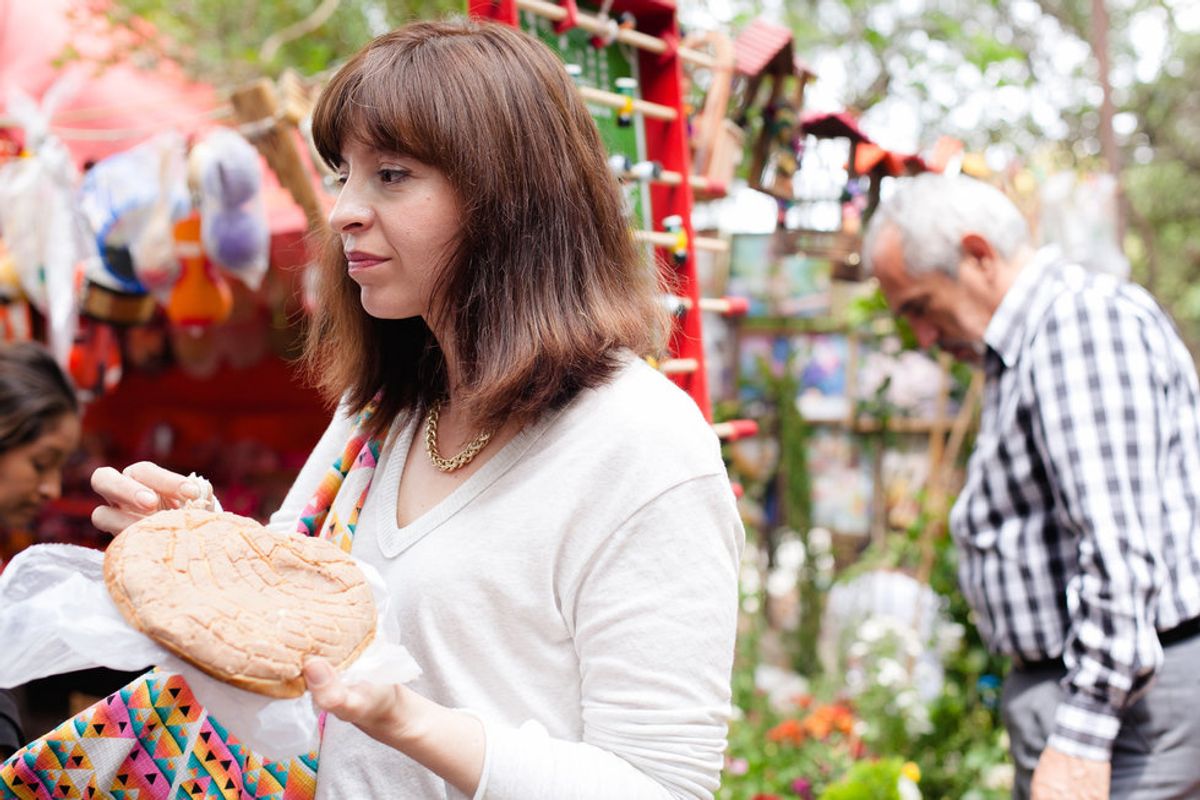Here in the Bay Area, diners are spoiled with excellent renderings of cuisines from around the world.
But while we all like to embark upon the flavor trip provided by a seat in a Japanese, Chinese, Indian, Italian, Pakistani, or Mexican restaurant, for chefs who moved here from those countries to cook, the experience is altogether different.
When we travel, we're aware of what it means to be a foreigner—the language is unknown, habits differ from ours, even such simple things as fruits may be unrecognizable. For chefs who've expatriated here, they must learn to translate not just words but also flavors, ingredients, and preferences particular to the Bay Area foodie scene—all while trying to maintain and celebrate their own culinary and cultural heritage.
We caught up with three trailblazing women whose kitchens are heating up the Bay Area dining scene of late to see how they bring their personal styles of cuisine and culinary traditions to the table. "The Bay Area is known for pioneering and for the quality of its products," says chef Tanya Holland, so if you are open-minded and good at what you do, doors will open, no matter who you are and where you come from."
And since it's nearly Thanksgiving, the chefs were kind enough to share with us their favorite recipes for the holiday, inspired by their own unique backgrounds.
Dominica Rice Cisneros, Cosecha Cafe
As a second generation Mexican-American born and raised in Los Angeles, Dominica Rice Cisneros, chef/owner of Oakland's popular Mexican eatery Cosecha Cafe, adapts her family's own recipes for a Californian palate.
7x7: How did you find your comfort zone in the Bay Area?
DRC: I moved here in 1993 and it was a total change of pace from L.A. It felt like a homecoming. The Bay Area at that time was a community of scholars, educators, artists, and revolutionaries. Coming from L.A., things were very flashy. Here in the Bay Area, they see right through it. They want to see the truth in your cooking and your skills; they want to see the real you. They want to see your history and your politics on the plate. The community here forces you to answer these questions. I loved the conversation and the cultural shift.
7x7: How do you meld Mexican culinary traditions with those of California?
DRC: Well, as a proud Mexican American, I see my culture in the food of California. It was my grandmother who came here from Mexico. But California cooking is very Mexican, as is the culture—those flavors have always been here. The heart of California cuisine is Chicana. Mexican and indigenous influences have been here for about 250 years; I am so happy that we are carrying on these traditions.
7x7: How do you celebrate Thanksgiving?
DRC: I have always been blessed to have an amazing mother who prepared a traditional Thanksgiving meal with all the fixings. Later I was blessed to have Thanksgiving dinner with my father-in-law, who prepared stuffing with walnuts straight from his orchards. But the thought of the holiday gives my husband a stomach ache and my daughter is a terribly picky eater. So I no longer prepare Thanksgiving dinner. We leave the country.
7x7: Can you give us a recipe for a non-traditional Thanksgiving dish?
DRC: My non-traditional Thanksgiving recipe is a plane ticket to Oaxaca, Mexico, where one should eat as many turkey mole tamales as one can. I usually travel around Mexico and climb pyramids. But one good recipe could be the pomegranate jicama salad with persimmon...
Domenica's Pomegranate Jicama Salad with Persimmon

(Clara Rice)
Serves 4-6 people
Ingredients
1 large jicama peeled, washed, and sliced into matchsticks
2 peeled and shaved persimmons, thinly sliced to remove any seeds or stems
The seeds of 1 large pomegranate
10 mint leaves, thinly sliced
1/2 cup toasted pumpkin seeds
1 head butter lettuce or winter chickories, washed and quartered
Vinaigrette
Zest of 1 large orange plus the juice
Zest of 2 yellow lemons plus the juice
1 shallot or red onion, chopped
1 garlic clove, smashed
1/4 cup Champagne vinegar
1 tablespoon sugar
1 teaspoon salt
Cracked black pepper to taste
1/4 cup California olive oil
Preparation
1. To make the vinaigrette, combine the citrus zest and juice, shallots, garlic, vinegar, sugar, and salt and pepper. Let sit for five minutes; add 1/4 cup California olive oil. Refrigerate (up to two weeks).
2. Have all the veggies prepped before dinner.
3. Add vinaigrette at last minute to serve.
Chef Reem Assil, Reem's California & Dyafa

Chef Reem Assil working the farmers market.
(Brooke Anderson)
Raised in a Palestinan-Syrian family in Boston, it was here in the Bay Area that Reem Assil—baker/chef/owner of Reem's California and Dyafa—learned to cook with the flavors of her Middle Eastern heritage, taught by her aunt and uncle, who took her to the farmers market to source fresh vegetables. The taste and the juicy flavor of the fruits and the veggies were so delicious and healthy that Assil was able to heal herself of severe acid reflux, and the whole experiment inspired her to become a chef. In 2015, supported by La Cocina, she got her start selling Middle Eastern–style flatbreads at the Ferry Plaza Farmers Market. In 2017, she opened Reem's California, a corner bakery serving Arab-style street food in Fruitvale, and in 2018 she opened Dyafa, a Middle Eastern restaurant at Oakland's Jack London Square in partnership with Daniel Patterson.
7x7: How did you find your comfort zone in the Bay Area?
RA: I came from the East Coast, Boston, where people are more conservative. When I moved to the Bay Area, it was easy to find my comfort zone because this is really the place you come to express yourself and to find your voice. I was able to build a community that shares my values around social justice, activism, and the concept of making the world a better place.
7x7: How are you bringing your own culinary heritage into your Oakland restaurants?
RA: In the Levantine culture, the freshness of vegetables is very important, and the climate in those countries is very similar to California. Arabic cuisine is also really based on seasonality, and this is similar to California also. In the Bay Area, thanks to the help of my family, I learned to cook the food I grew up with, going to the farmers market every week to buy fresh vegetables with my uncle and aunt. In my restaurants, it is all about planning around those seasons. For instance, this is the season of pomegranate, and we use it in many of our dishes. We use the juice to sweeten the stew, to add to savory pies, like a lamb-based pie. Before starting a new recipe, I talk a lot with my family, then I share my idea with my Bay Area community. I combine everything together and I create the dish.
7x7: Do you celebrate Thanksgiving?
RA: I take Thanksgiving with a salt of grain because it is not a holiday that belongs to my roots. So we make it something else. Growing up in an Arab house, we would celebrate Thanksgiving with an Arab potluck. My mom would made a non-traditional Turkey stuffed with rice, beef, peanuts, turmeric, plus a lot of vegetables and pita bread.
7x7: Got a recipe you can share?
RA: I like to make ma'amoul cookies. I am a baker first, and I enjoy making these cookies for Thanksgiving. They are semolina butter cookies stuffed with a variety of ingredients, either with walnuts or pistachios and sometimes dates. At Reem's, we like to do a California spin. There is a coffee roastery next to the bakery, and we infuse our dates with their espresso and then we use it to make the cookies.
Reem's Ma'amoul Cookies
Serves 10
5 cups of semolina flour
2 1/4 cups of all-purpose flour
4 cups of melted clarified butter
1 cup of sugar
1 tsp of mahlab (found at international or Middle Eastern stores)
2 cups of milk
1 tsp of yeast
3/8 cups of orange blossom water
16 ozs Filling of your choice
Preparation:
1. In a mixing bowl, pour warm melted butter and oil over semolina, AP flour, and mahlab. Let rest for at least at an hour.
2. Dissolve yeast in 1/4 cup warmed milk. Heat the remaining 3/4 cup almost to a boil and dissolve sugar. Add the orange blossom water.
3. Add all wets to the dry mixture and knead well to achieve a uniform elastic and moist dough, adding more flour if needed.
4. Cover and put in warm place to rest for half an hourbefore forming cookies.
5. Preheat the oven to 325 degrees.
6. Form a ball of dough about 1.5 to 2 inches diameter in the palm of your hands. Use the palm of one hand to support while making a cup or hollow by pressing the dough to an even thickness all around using the index finger on your other hand.
7. Place roughly 1 teaspoon of filling into hollow and pinch closed, reshaping it into a round between your palms.
8. Press into a wooden mold and pop out onto a baking sheet. Bake for 30 minutes until ever so slightly golden.
9. Cool cookies completely, and then sift powdered sugar over the tops.
Chef Tanya Holland, Brown Sugar Kitchen

Chef Tanya Holland.
(Smeetha Mahanti)
Brown Sugar Kitchen chef/owner Tanya Holland is known for her creative and innovative take on modern soul food—updating a cuisine rich in flavor and tradition. Raised in Rochester, New York, in a family that hailed from the South, Holland grew up eating soul food and later trained in France. With the dream of marrying her African-American food traditions and her training in both French and Southern-style cuisines, she developed a contemporary version of soul food at Brown Sugar Kitchen, which recently opened in the San Francisco Ferry Building.
7x7: How did you find your groove in the Bay Area?
TH: The minute I moved to Oakland, I finally found a community that embraced the diversity and the interaction I was looking for. I felt immediately in the right place. The people in this community were all open-minded and they really understood what I was trying to create. I lived on the East Coast and I tried to open a restaurant in New York, Boston, and Philadelphia, but it was very hard for a woman of color like me. In the industry nobody could take me seriously, and I struggled to find the right support. In California, and the Bay Area most of all, If you are good at what you do, doors open no matter who you are.
7x7: How do California's culinary tenets support your work with soul food?
TH: California is rich agriculturally—there are a lot of resources and fresh products available, and that is what soul food is about.
7x7: Do you celebrate a traditional Thanksgiving?
TH: Working in the food industry, Thanksgiving means I have a day off. Usually, I spend the day with my friends, where we enjoy good food and wine. I used to be more traditional in celebrating Thanksgiving when I was married, but now, for me, it is more about spending time with friends."
7x7: What's your favorite Thanksgiving recipe?
TH: Cornbread stuffing. I love it and I can eat it everyday.
Tanya's Fig, Pecan, and Sausage Cornbread Stuffing

Serves 8 to 10
Ingredients:
For a 2-quart glass or ceramic baking dish (12"x8-1/4"x2-1/2")
1 recipe plain buttermilk cornbread (see confetti cornbread recipe)
1 pound pork sausage (Holland prefers spicy Italian)
1 cup Madeira wine
3/4-pound dried Calmyrna figs, stemmed and cut into eighths (about 2 cups when prepped)
2 cups pecan pieces, toasted
8 ounces unsalted butter
3 cups finely chopped onions
1.5 cups finely chopped celery
2 tbsp chopped sage
2 tbsp chopped thyme
2 tbsp chopped rosemary
2.5 tsp coarse salt
1 tsp ground white pepper
Preparation:
1. Heat oven to 350 degrees.
2. Prepare cornbread; when cooled, crumble and set aside in a large bowl. Remove sausage from casing if necessary and crumble.
3. Cook sausage in a skillet over medium heat until cooked through; set aside. Place Madeira and prepped figs in a small saucepan over medium heat in order to re-hydrate figs. All of the liquid should be evaporated; this takes about 10 minutes.
4. Toast pecans in a small skillet over low heat for about 5 minutes. In a large skillet, melt butter and add onions and celery. Cook over low to medium heat until vegetables are soft and translucent, about 10 minutes.
5. Add herbs, salt, and pepper, and cook an additional 5 minutes. Add sausage, figs and onion mixture to the crumbled cornbread and loosely mix, using a wooden spoon or large kitchen spoon. Gently press stuffing mixture into baking dish; the top should be textured and rustic, not smooth. Bake stuffing for 1 hour at 350 degrees.
Confetti Cornbread
1 egg
11⁄2 cups/ 360 ml buttermilk
1 cup/ 125 g all-purpose flour
1 cup/ 140 gstone ground cornmeal
4 teaspoons baking powder
1⁄2 teaspoon baking soda
2 teaspoons kosher salt
1 tablespoon granulated sugar
1⁄2 cup/ 115 g unsalted butter
2 tablespoons chopped green chiles
1 red bell pepper, seeded, deribbed, and diced
3 green onions, white and green parts, chopped
3⁄4 cup/ 180 ml cooked corn kernels
1. Place cast iron skillet in an oven heated to 425°F/220°C.
2. In a mixing bowl, whisk together egg and buttermilk.
3. In a separate bowl, mix together flour, cornmeal, baking powder, baking soda, salt, and sugar.
4. Add dry ingredients to buttermilk mixture and mixwith a wooden spoon; do not over mix.In a small sauté pan or skillet, melt butter. Add chiles, bell pepper and green onions.
5. Cook and stir over medium heat until vegetables are soft, about 10 minutes. Fold pepper mixture and corn into the cornbread batter.
6. Remove cast iron skillet from oven and grease with vegetable spray or brush with melted butter.
7. Pour batter into skillet and bake for 20to 25 minutes, until cornbread is brown and a wooden pick inserted near the center comes out clean. Makes 8 servings





















